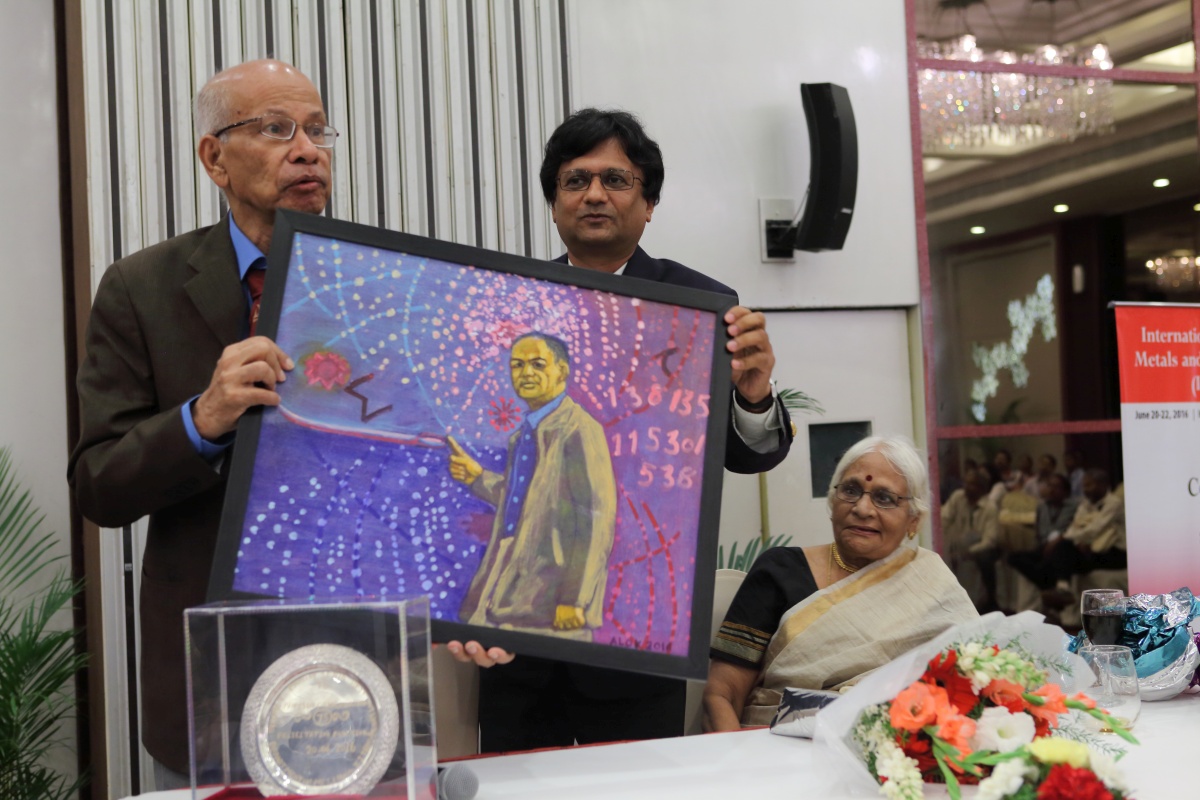Location:
Faculty Hall
Punit Kumar*, Gyan Shankar*, Sweety Arora*

Alok Singh presenting his painting of S Ranganathan (Credit: Organizing Committee, ICMR 2016)
An International Conference on Metals and Materials Research (ICMR) was organized in honour of S Ranganathan, an emeritus professor in the Department of Materials Engineering, on the occasion of his 75th birthday on 20 June 2016. ICMR, held during 20–22 June 2016, was hosted by the Department in association with the Bangalore chapter of the Indian Institute of Metals.
The conference saw many luminaries from the field discuss the latest innovations in materials technology. The ball was set rolling by one of India’s most well-known chemists, CNR Rao (JNCASR, Bangalore) who inaugurated the conference. He spoke about 2D inorganic materials and 2D single-layer materials which could have electronic properties similar to graphene, such as molybdenum sulphide (MoS2), gallium sulphide (GaS), gallium selenide (GaSe) and a form of boron cyanide (BCN). In his address, he also urged materials scientists in India to develop new materials that we could call “our own”.
Two of Ranganathan’s former students, BS Murty (IIT Madras) and VS Raja (IIT Bombay), along with Satyam Suwas (Materials Engineering, IISc), co-chaired the conference. In the first plenary session, AL Greer (University of Cambridge, UK) analyzed processes that are presently popular for improving the mechanical behaviour of amorphous forms of metals known as bulk metallic glasses. Barry Carter (University of Connecticut, USA) discussed how the development of latest characterization techniques had changed the way researchers look at materials. K Chattopadhyay (Chairperson, Interdisciplinary Centre for Energy Research, IISc) addressed the challenges associated with the development of new alloys. He highlighted the progress made by his research group in the development of new series of cobalt-based superalloys. These low-cost superalloys could improve the efficiency of energy generation in thermal power plants and of chemical processes in oil refineries.
In parallel technical sessions, U Kamachi Mudali (IGCAR, Kalpakkam) shed light about the indigenously developed high-nitrogen stainless steel for use in nuclear power plants. SV Kamat (DMRL, Hyderabad) spoke about futuristic materials which could potentially find applications in defense. Pradip P (TCS, Pune) presented a state-of-the-art Integrated Computational Materials Engineering platform for fabrication of engineering materials and products, developed by TCS. The first day of the conference ended with a felicitation program in honour of Ranganathan, whose work in materials research spans more than half a century.
In the second plenary session of the conference, A Inoue (Tohoku University, Japan) showed how a small geared motor, with a diameter of 1.5 mm, was fabricated using metastable amorphous alloys. S Banerjee (BARC, Mumbai) revealed how laser-processed cast iron skillets could be utilized for oil-less cooking. BS Murty explained the challenges associated with the fabrication of high-entropy alloys. Satyam Suwas talked about grain boundaries engineering, a novel way for material processing. Using this method, the ductility of metals can be improved without much reduction in their strength. Dheepa Srinivasan (GE, Bangalore) explained the potential of modern technology “additive manufacturing” as the future of repair technology. Shardha Srinivasan (NIAS, Bangalore) took the audience back in time by highlighting the efforts to bring to light the glorious history of metallurgy in India through the archeological findings of Iron Age high-tin bronzes from Tamil Nadu.
*Punit, Gyan, and Sweety are PhD students in the Department of Materials Engineering


